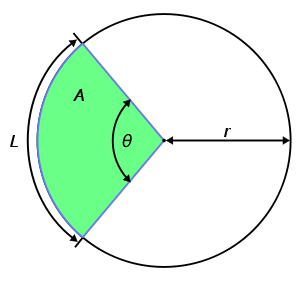
Circular sector
Encyclopedia

Disk (mathematics)
In geometry, a disk is the region in a plane bounded by a circle.A disk is said to be closed or open according to whether or not it contains the circle that constitutes its boundary...
enclosed by two radii
Radius
In classical geometry, a radius of a circle or sphere is any line segment from its center to its perimeter. By extension, the radius of a circle or sphere is the length of any such segment, which is half the diameter. If the object does not have an obvious center, the term may refer to its...
and an arc
Arc (geometry)
In geometry, an arc is a closed segment of a differentiable curve in the two-dimensional plane; for example, a circular arc is a segment of the circumference of a circle...
, where the smaller area is known as the minor sector and the larger being the major sector. In the diagram, θ is the central angle
Central angle
A central angle is an angle which vertex is the center of a circle, and whose sides pass through a pair of points on the circle, thereby subtending an arc between those two points whose angle is equal to the central angle itself...
in radian
Radian
Radian is the ratio between the length of an arc and its radius. The radian is the standard unit of angular measure, used in many areas of mathematics. The unit was formerly a SI supplementary unit, but this category was abolished in 1995 and the radian is now considered a SI derived unit...
s, the radius of the circle, and is the arc length of the minor sector. A sector with the central angle of 180° is called a semicircle
Semicircle
In mathematics , a semicircle is a two-dimensional geometric shape that forms half of a circle. Being half of a circle's 360°, the arc of a semicircle always measures 180° or a half turn...
. Sectors with other central angles are sometimes given special names, these include quadrants (90°), sextants (60°) and octants (45°). The angle formed by connecting the endpoints of the arc to any point on the circumference that is not in the sector is equal to half the central angle.
Area
The total area of a circle is . The area of the sector can be obtained by multiplying the circle's area by the ratio of the angle and (because the area of the sector is proportional to the angle, and is the angle for the whole circle): Another approach is to consider this area as the result of the following integral : Converting the central angle into degreeDegree (angle)
A degree , usually denoted by ° , is a measurement of plane angle, representing 1⁄360 of a full rotation; one degree is equivalent to π/180 radians...
s gives
Perimeter
The length of the perimeterPerimeter
A perimeter is a path that surrounds an area. The word comes from the Greek peri and meter . The term may be used either for the path or its length - it can be thought of as the length of the outline of a shape. The perimeter of a circular area is called circumference.- Practical uses :Calculating...
of a sector is the sum of the arc length and the two radii:

